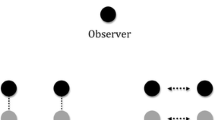Abstract
Two experiments are presented studying interrelations between spatial properties of environments and both experience and spatial behavior. In order to systematically study such interrelations, a generic description of space is required that provides comparability between arbitrarily shaped environments and captures behaviorally relevant properties of space. In this study the suitability of isovist derived measurands for this purpose was explored. Isovist-based descriptions of 16 virtual indoor scenes were correlated with behavioral data from two experimental tasks. For both tasks, an active navigation task and a rating of experiential qualities, strong correlations between subjects’ behavior and measurands derived from isovist analysis were found. The general outcomes suggest that isovist measurands are indeed a promising means to predict the experience of space and spatial behavior for the chosen experimental tasks.
Access this chapter
Tax calculation will be finalised at checkout
Purchases are for personal use only
Preview
Unable to display preview. Download preview PDF.
Similar content being viewed by others
References
Appleton, J.: Prospects and refuges revisited. In: Environmental aesthetics: Theory, research, and application, pp. 27–44. Cambridge University Press, New York (1988)
Benedict, M.L.: To take hold of space: Isovists and isovists fields. Environment and Planning B 6, 47–65 (1979)
Berlyne, D.E.: Conflict, Arousal, and Curiosity. McGraw-Hill, New York (1960)
Berlyne, D.E.: Aesthetics and Psychobiology. Appleton, New York (1972)
Bülthoff, H.H., van Veen, H.A.H.C.: Vision and action in virtual environments: Modern psychophysics in spatial cognition research. In: Jenkin, M., Harris, L. (eds.) Vision and Attention, pp. 233–252. Springer, New York (2001)
Ching, F.D.K.: Architecture Form Space and Order, 2nd edn. Van Nostrand Reinhold, New York (1996)
Franz, G., von der Heyde, M., Bülthoff, H.H.: Predicting experiential qualities of architecture by its spatial properties. In: Martens, B., Keul, A.G. (eds.) Evaluation in progress - Strategies for environmental research and implementation (IAPS 18 conference proceeedings on CD-ROM) (2004), http://www.kyb.mpg.de/publication.html?publ=2432
Hillier, B.: Space is the Machine. Cambridge University Press, Cambridge (1996)
B. Hillier. The common language of space: a way of looking at the social, economic and environmental functioning of cities on a common basis (September 1998), http://www.spacesyntax.org/publications/commonlang.html
Hillier, B., Hanson, J.: The Social Logic of Space. Cambridge University Press, Cambridge (1984)
Hillier, B., Major, M.D., Desyllas, J., Karimi, K., Campos, B., Stonor, T.: Tate gallery, millbank: a study of the existing layout and new masterplan proposal. Technical Report 5, Bartlett School of Graduate Studies, University College London, London, UK (1996)
Janzen, G., Herrmann, T., Katz, S., Schweizer, K.: Oblique angled intersections and barriers: Navigating through a virtual maze. In: Habel, C., Brauer, W., Freksa, C., Wender, K.F. (eds.) Spatial Cognition 2000. LNCS (LNAI), vol. 1849, p. 277. Springer, Heidelberg (2000)
Janzen, G., Schade, M., Katz, S., Herrmann, T.: Strategies for detour finding in a virtual maze: The role of the visual perspective. Journal of Environmental Psychology 21, 149–163 (2001)
Kaplan, S.: Perception and landscape: conceptions and misconceptions. In: Environmental aesthetics: Theory, research, and application, pp. 45–55. Cambridge University Press, New York (1988)
Krier, R.: Über architektonische Komposition. Klett-Cotta, Stuttgart (1989)
Leyton, M.: A generative theory of shape. Springer, Berlin (2001)
Newman, O.: Creating Defensible Space. US Department of Housing and Urban Development, Washington (1996)
O’Neill, M.J.: Effects of familiarity and plan complexity on wayfinding in simulated buildings. Journal of Environmental Psychology 12, 319–327 (1992)
Psarra, S., Grajewski, T.: Describing shape and shape complexity using local properties. In: Peponis, J., Wineman, J., Bafna, S. (eds.) Proceedings 3rd International Space Syntax Symposium, A. Alfred Taubman College of Architecture and Urban Planning, University of Michigan, pp. 28.1–28.16 (2001)
Stamps, A.E.: Psychology and the aesthetics of the built environment. Kluwer, Boston (2000)
Turner, A., Doxa, M., O’Sullivan, D., Penn, A.: From isovists to visibility graphs: a methodology for the analysis of architectural space. Environment and Planning B 28(1), 103–121 (2001)
Turner, A., Penn, A.: Making isovists syntactic: isovist integration analysis. Paper presented at the 2nd International Symposium on Space Syntax, Brasilia (April 1999)
Werner, S., Long, P.: Cognition meets le corbusier - cognitive principles of architectural design. In: Freksa, C., Brauer, W., Habel, C., Wender, K.F. (eds.) Spatial Cognition III. LNCS (LNAI), vol. 2685, pp. 112–126. Springer, Heidelberg (2003)
Wiener, J.M., Mallot, H.A.: Fine-to-coarse route planning and navigation in regionalized environments. Spatial Cognition and Computation 3(4), 331–358 (2003)
Wohlwill, J.F.: Environmental aesthetics: The environment as a source of affect. In: Human Behavior and Environment, vol. 1, pp. 37–85. Plenum Press, New York (1976)
Author information
Authors and Affiliations
Editor information
Editors and Affiliations
Rights and permissions
Copyright information
© 2005 Springer-Verlag Berlin Heidelberg
About this paper
Cite this paper
Wiener, J.M., Franz, G. (2005). Isovists as a Means to Predict Spatial Experience and Behavior. In: Freksa, C., Knauff, M., Krieg-Brückner, B., Nebel, B., Barkowsky, T. (eds) Spatial Cognition IV. Reasoning, Action, Interaction. Spatial Cognition 2004. Lecture Notes in Computer Science(), vol 3343. Springer, Berlin, Heidelberg. https://doi.org/10.1007/978-3-540-32255-9_3
Download citation
DOI: https://doi.org/10.1007/978-3-540-32255-9_3
Publisher Name: Springer, Berlin, Heidelberg
Print ISBN: 978-3-540-25048-7
Online ISBN: 978-3-540-32255-9
eBook Packages: Computer ScienceComputer Science (R0)




